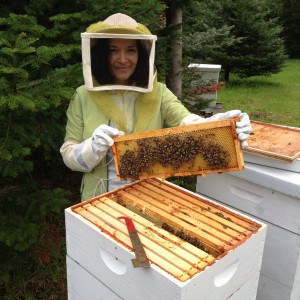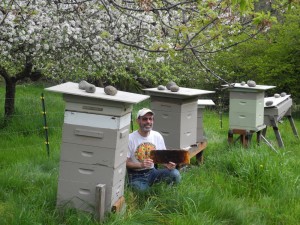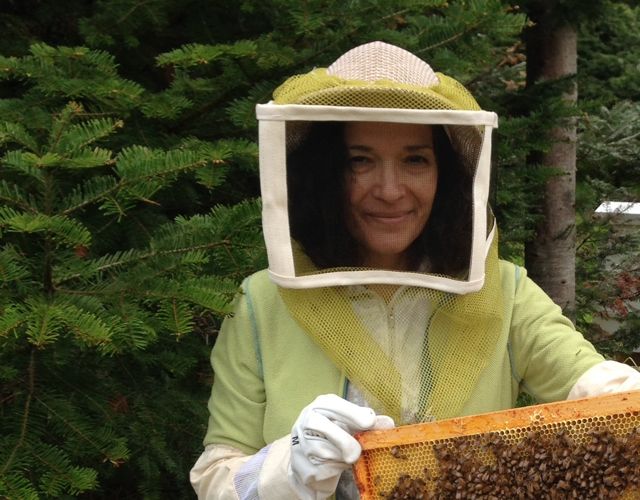By Doris Faltys
 “I have a bee swarm,” my friend Gloria Temple announces over the phone. “I can’t come over for tea. You come here!”
“I have a bee swarm,” my friend Gloria Temple announces over the phone. “I can’t come over for tea. You come here!”
Temple has contacted fellow beekeeper Rich Kalman to come to her home to capture the swarm. When I arrive, the bees have come to rest in a tree. There is one cluster near the ground and three more clusters are hanging by a branch about eight feet in the air. I stand at some distance watching, while Kalman spreads a white cloth on the ground under the clusters with a bee hive box ready to receive the bees.
“It is unusual to see the bees in separate clusters,” Kalman tells us.” There is only one queen and they cluster around her. I am just guessing, but it is possible she lit on different spots on the branch and left some of her scent. I think the bees will come together soon.”

Shortly, we notice that one by one bees are leaving the clusters and within five minutes all the bees are in one cluster lower to the ground.
Kalman has put on a protective bee jacket and hood, but his hands are bare.
“You don’t wear gloves,” I ask.
“Bees are usually docile during a swarm,” says Kalman.
Kalman then picks up a spray bottle and sprays the cluster with sugar water. “It makes their wings sticky and the bees are reluctant to fly. It also gives the bees something to do as they lick the sugar water off each other,” he explains.
Kalman picks up a small pair of clippers and cuts the branch above the cluster. He holds up the cluster for a photo and then lays the branch on top of the open beehive box. The bees immediately begin to flow from the cluster into the box. It takes some time, since there are about 15,000 bees. Kalman picks up the end of the branch and gently shakes off the remaining bees.
Kalman first learned about bee keeping many years ago during his time as a volunteer salmon steward for Stream Team.

“A fellow steward was a beekeeper,” Kalman reflects. “As we waited for people to ask us questions about salmon, she told me all about her bees and the Olympia Beekeepers Association. I went to a meeting and then signed up for a free class for beginner beekeepers. I soon fell in love with bee keeping.”
A retired teacher, Kalman happily explains bee swarms. “Swarms are common in March and April, initiated by rapid growth of the hive. They are triggered when the worker bees realize their numbers have exceeded available space, or there are so many bees that they don’t get enough of the queen’s pheromone.
“The type of food the worker bees feed a larva determines whether it will become a queen rather than a worker or drone. If a new queen is needed, the workers feed a few larva a steady diet of royal jelly, much more than ordinary larvae get. Then worker bees enlarge the selected larvae’s wax cells to create queen cells. They seal up the cells until the pupae turn into a few queens.
“The workers also stop feeding the current queen, so she regains her ability to fly. Sometime between the time the queen larva are sealed and it emerges, within 24 days from the time the queen eggs are laid, they kick the old queen out of the hive.
“Tens of thousands of bees come out and follow the queen; about 40% of the hive continues with the queen. The rest go back to the hive and await the emergence of the new queen.

“The bees don’t go very far. They follow the queen’s scent and form a cluster around her. About 1% of bees go out as scouts to find a new home.”
The story turns a little gruesome at this point, as Kalman continues.
“The first queen to emerge in the old hive kills the remaining queens. At some point the new queen will go out to mate with 12-45 drones. She only mates that one day. She collects sperm in a vessel inside her body. She will lay hundreds of thousands of eggs all from that one day mating until she runs out of sperm. Then the bees will kill her and make a new queen.”
The bees have now entered the new hive and Temple talks to me about her bees. “Bees are my best guests,” she says. “It started out as what appeared to be an easy hobby for us. We have a small orchard of fruit trees that need pollinators and my husband, Jerry, loves honey to sweeten his tea. We began this hobby about five years ago. There were some intimidating moments, like installing the first packet of bees and their queen into our first hive and being surrounded by the buzzing of thousands of bees.”

“We are very appreciative of all the work our bees go to, and of the honey they supply us with,” explains Temple. “The best part, I think, is that as we hear of the struggle bees are having around the country. I know that we are contributing to their growth simply by giving them a friendly environment in which to live.”
Kalman adds, “Ordinary people can help increase bee populations by planting a variety of plants that bees can use for forage.” Click here for more information regarding plants for bees.
Temple called this morning to report another swarm at her home over the weekend. This cluster formed on one of her garden fence posts.
If you see a bee swarm call (360) 515-1068. Swarm Line coordinator Gail Booth will contact a beekeeper to come and collect the swarm. Interested in becoming a beekeeper? The Olympia Beekeepers Association, hold monthly meetings.

















































